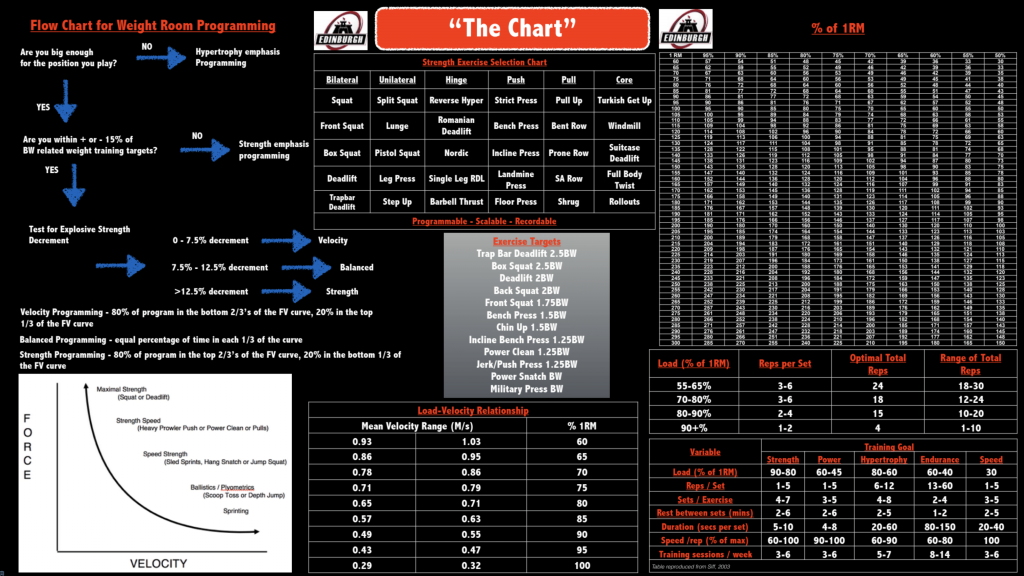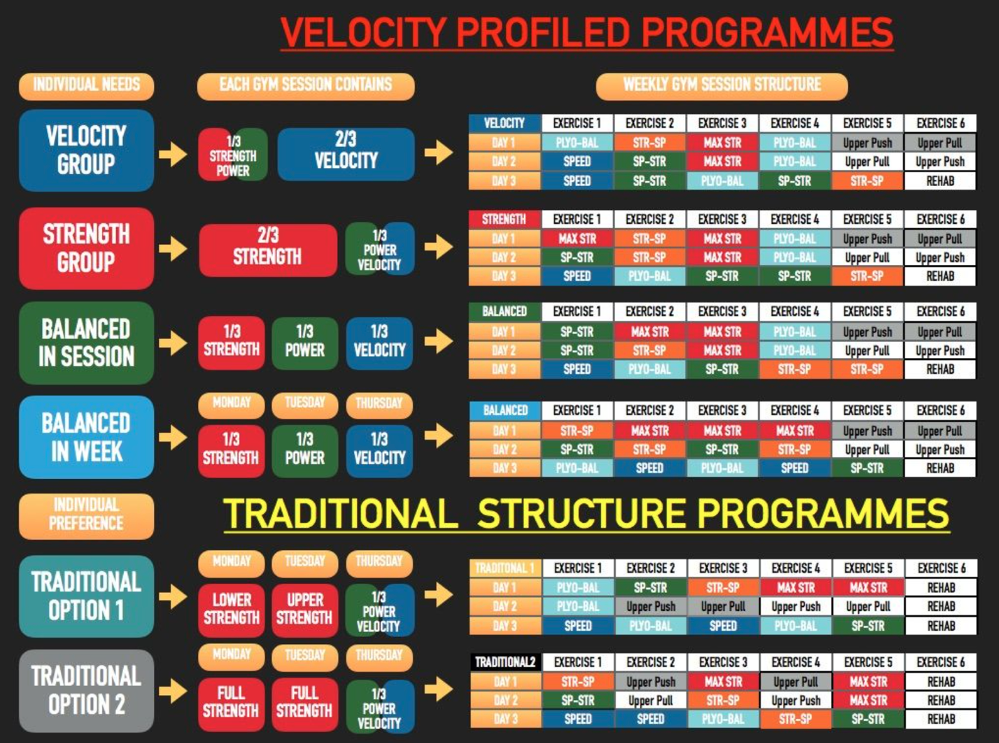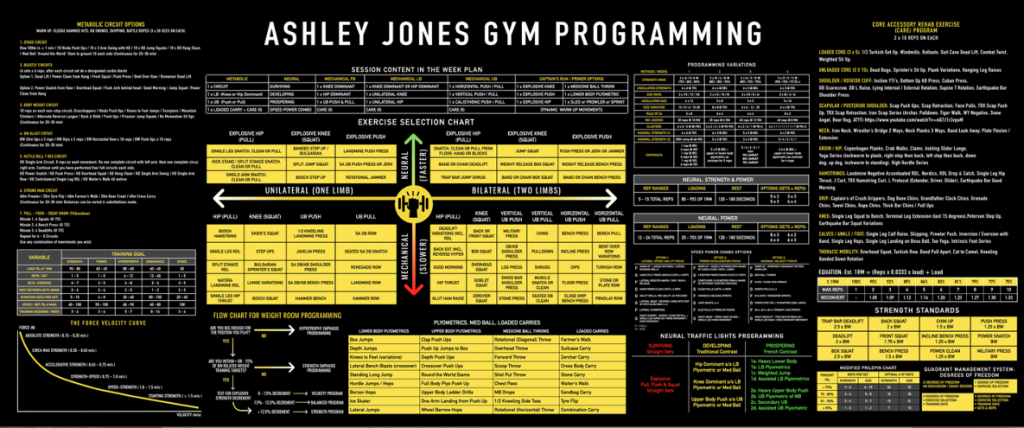
The exercise selection chart serves as the core of my training decisions based on. It's based on the “degrees of freedom” Quadrant Management System (QMS) for programming gym sessions. The other two "degrees of freedom" are sets and reps periodization and the days of the week that players train.
Three Main Areas
I have three main areas where I program from—metabolic, mechanical, and neural. Metabolic is more circuit-fitness-based in nature. Mechanical is related to size and strength. Neural is about speed and explosiveness. The mechanical and neural are highlighted in The Exercise Selection Chart as distinct areas to choose exercises and programs from.
I have accumulated many different training options over a number of years.
These training options form the basis of my decision-making. The conversations with players determine what they need to focus on over the next four to six weeks. I attempt to introduce the players to a number of different loading structures in order to educate them as to what each of the various methods can result in gains in performance. As players work through the QMS, they can make informed choices as to which of the sets and reps methods work best for them in a given training block. Depending on the training age of the player, this element could be either the second or the third degree of programming freedom.
The final element is the number of days a week a player decides to train and the actual content of each of those training sessions. This level of freedom takes into consideration what the focus of the training block is as far as the needs-based approach that I consider a key component of coaching. It also looks at the overall training week plan with skill practices, contact sessions, team sessions, and also recovery from the game and activation leading into the game. All these components need to be weighed to ensure we have the opportunity to express ourselves fully on game day and ensure our processes are leading to the desired outcome of a win. All coaches and players are process-driven but outcome judged.
Player Needs
I have included as many variations on content and training days to ensure that each player has options to determine what works best for them in their individual preparation within the team environment. Consider training age and type of programming that the player needs: split programming, combination programming of speed and power, and full-body programming. Take into consideration the other team-specific sessions that need to be done and the impact of the gym on those sessions and those sessions on gym-based training.
The QMS has grown into the chart that I have included below. This has at its core the "three degrees of freedom" of the system. It also has a wider reference to provide a player with all the choices they need to make informed decisions around the program. I use it as a teaching tool and a reference point for players to learn more about what works best for them. It allows me to have conversations with each player around the WHY of programming and then look at the WHAT and HOW we are going to program to positively effect performance both for the weekend and the duration of the training year.
My first attempts with the development of a similar chart were done during my time at Edinburgh Rugby. It's there I was working with great coaches and physio staff, Marc Keys and Tracy McAdam. The attempt was to provide the players and ourselves with a point of reference.
The Chart

I have received many great ideas from around the strength and conditioning world. The aspect of educating the playing group is always the center of the discussion. One of the most innovative strength and conditioning coaches is Gareth Duder. He currently coaches the Crusaders Rugby Team out of Christchurch, New Zealand. He shared his thoughts around velocity training following many of our discussions. Here is his chart based around an emphasis on more strength programming (or velocity programming, or a balanced approach). These decisions are based on Explosive Strength Decrement testing and the use of velocity-based training. Furthermore, these decisions are in conjunction with one-on-one discussions with each of his playing groups.
Velocity Profiled Programmes
Here is Gareth's chart. His genius lies in its simplicity and the buy-in from the playing group. Notice the clarification that this method brings to the training reality.

To conclude, I would like to share my combined seasonal training chart. This chart below allows me to develop programs at any stage of the training year in discussion with each player. Therefore, the players have the tools to determine the details of their program to minimize the risk of injury. They can also optimize the performance outcome. Click this link to download the chart in publisher so you can alter and make your own adjustments if required. Many thanks to the wonderful work of Katy Nora who painstakingly pieced the chart together with her skills in publisher.
The Combined Season Training Chart

Ashley Jones has just completed his 30th pre-season in professional sport, working across three professional sports on four continents. Ashley currently plies his trade in Major League Rugby (MLR) with the Houston Sabercats as their Head of Performance.










I just wanted to get clarity on the (flow chart on weight-room programming), at the end its states that you must test explosive strength decrements. How do you go about that, do you have fixed exercise for that. Im just trying to understand that part so I may be able to group my players accordingly.
looking forward to your response. Thank you
Thanks again for your always informative articles.
Thanks again for all the great information
https://www.scienceforsport.com/dynamic-strength-index/
https://www.scienceforsport.com/strength-power-tests/
https://simplifaster.com/articles/dsi-explosive-strength-deficit/
https://www.dropbox.com/s/r4ak5dmgv3jcoty/Ashley.Jones.Gym.Programming.pdf?dl=0
https://www.dropbox.com/s/axs5bic0tiro5nl/ASH.INSEASON.PROGRAM.psb.psd?dl=0
https://www.dropbox.com/s/2z1dfkmfh361qy8/ASH.PRESEASON.PROGRAM-Recovered.psb.psd?dl=0
https://www.dropbox.com/s/r4ak5dmgv3jcoty/Ashley.Jones.Gym.Programming.pdf?dl=0
Thanks for this amazing article ! But unfortunately we can't have access to your final table even with the link you share....
Thanks for this amazing article !
But unfortunately we don't have access to the full chart...